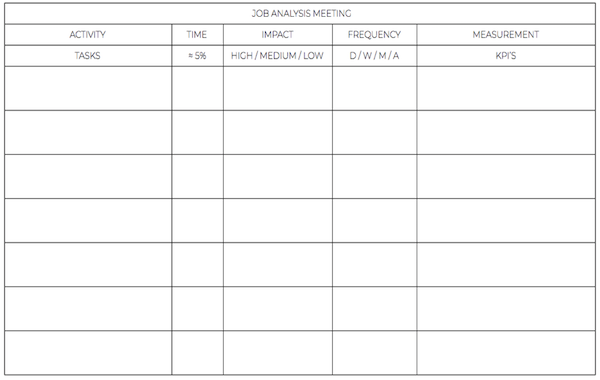I’m going to let you into a secret. There’s a method that I’ve introduced to my CEO clients which they’ve found transformational. Not only does it massively improve the accuracy of recruitment. It also increases motivation, performance and energy in the business. What is this hard-hitting formula? Creating a job scorecard.
In last week’s blog, I talked about the importance of regular talent assessment and ways you could rank staff performance as A, B and C in your organisation. Your aim has to be getting the percentage of A-Players up to 90% if you can (the definition of an A-Player being the top 5 to 10% of the available talent for a given job, salary and location). But in order to do this, you need a structure around job performance and expectations that everyone buys into and accepts. And you need a recruitment process that attracts only A-Players. This is where the job scorecard comes in.
What is a job scorecard?

Above is the template I use with clients to come up with a job scorecard for every role in their organisation. I suggest this replaces traditional job descriptions, with their endless and overwhelming laundry lists of unprioritised tasks.
It’s simple really. You take each role, whether it’s new or existing, and work your way through the grid. First, brainstorm all the tasks this person might be expected to do, even down to making the tea. Can some of these tasks be grouped together? Chunk them up if so. Then work out if any of the tasks you’ve listed are likely to take up 5% or less of that employee’s time? Put a line through them.
Begin to pare down to more critical tasks, each one with a percentage of time needed to perform it well. Mark them as high, medium or low impact – prioritising the tasks according to their value to your business. Then decide on the frequency of the task. Is it daily, weekly, monthly or annually?
Maybe you had 20 tasks on the list on the job scorecard when you started but you’re aiming to narrow it down to around 5. Then (and this is where the real magic happens), work out the KPI (Key Performance Indicator) that relates to each task. If it’s a new role, what would success look like a year from now? If it’s a sales role, you may decide that the measure is sales order intake. And the success criteria? How about £10k of monthly recurring revenue (MRR) in order value by month 12? What is it that they need to do in that task that will mark them out as an A-Player? These can be your measure and benchmark for all future performance discussions. They are also what you look for in interviews.
Ultimately, your organisation needs to get to a place where it’s attracting the right skills and everyone knows the expectations of their role. This process goes a long way towards answering the first question of the Gallup Q12 Staff Engagement Survey ‘I know what’s expected of me at work’. At the end of each day, you want every employee to know whether they’ve had a good, average or bad day and this information should flow bottom-up from the staff.
How does a job scorecard help recruitment?

Clients have said to me this has revolutionised the way they think about recruitment. Case in point: recently a client told me he needed a new salesperson. We went through the job analysis template and by the end, they realised that the tasks split 60% towards management and only 40% towards sales. Clearly, management ability was going to need a much higher profile in the interviews. Going through this process entirely changed their view of what they needed to recruit for.
Other impacts on recruitment include:
– Unifying expectations amongst stakeholders
At the beginning of any recruitment project, I suggest all the stakeholders gather together and work through the template. As in the example just mentioned, this can radically transform the conversation prior to taking a job to market. All parties can agree what they’re looking for based on a clear assessment of the priority of tasks in the job scorecard.
– Bringing clarity to every new role
Job analysis brings clarity to both candidates and the company. You’re focusing on five areas – the most important tasks – and looking for people who have achieved these things to this level in their previous work experience. It’s also clear how you’re going to measure these things in the role going forward.
Post interview, as each stakeholder discusses their view of the candidate, they can objectively give their thoughts based on his or her ability to deliver the five top priorities to the required standard.
– Showing potential for future development
Now, when a candidate asks you, ‘What do I need to be successful in this role’, you have the answer. The KPIs! It will be crystal clear what they need to achieve to be considered an A-Player in their role.
– Focusing job adverts
Your job advert is the first stage of the recruitment and its job is to filter as well as attract. Using a job scorecard cuts through the clutter that often ends up in the ad. It’s so specific that you can bring a laser focus to exactly what you’re looking for and who should apply.
– Tightening up the recruitment process
As with the advert, job analysis can transform the recruitment process. Take the interviews. I work with hundreds of clients but only a handful will have had formal interview training. And yet it’s absolutely fundamental. No-one fails to grasp the impact of hiring the wrong people and yet too little emphasis is given to getting recruitment right. Job analysis is something that you can introduce today that will start having an impact tomorrow. There’s no money to spend.
Whether you employ an external recruiter or have an internal interviewing panel, they will go into the interviews with a really clear spec. Questions can be specifically focused on the five task areas of the role and the corresponding KPIs. As a hiring manager, you can get your recruitment team to filter much harder. This has an impact all the way through – fewer CVs and interviews, more thorough screening and only the best candidates being put through. End result? You hire better people. Isn’t that the whole point of recruitment?
Why does a job scorecard improve internal performance and engagement?
Once a client is successfully using job analysis in recruitment, I suggest taking it through all levels of their business, starting with the executive team. It works really well if the directors create their scorecards collectively, getting clear on the five things they’re counting on each other to do well. They need to think ahead, a year from now, to decide whether they’re measuring the right things. Once they’re really familiar with the process, they can roll it out. This will result in:
– A consistent method for objective assessment, whatever the size of business
Under 100 staff and it’s relatively easy for every member of the executive team to tell you their opinion on staff performance. I had an executive team with me last week who quickly ranked all their staff – around 50% of their workforce are currently A-Players.
However, once the business has grown, it gets far more difficult. As a result, you need to put in a process like job analysis early to provide the data for objective ranking in the future. As mentioned earlier, this information should flow bottom-up from the staff themselves as a result of weekly performance conversations.
– Clarity over expectations

I can’t over-emphasise the value in every employee knowing what success looks like, how they’re going to be measured and how they should spend their time. Let’s face it. It’s so easy to spend 60% of your time doing email. But this is almost always low impact. By prioritising the important tasks, staff can then time-box their day to ensure they’re giving focus to the things that matter.
It’s all about expectations. Getting really clear. By working through the job analysis template, both manager and employee go through an iterative process together. The KPIs are a shared sense of expectation – both between the employee and manager, and the employee and the rest of team. When they start talking about performance, it’s based on an objective assessment, not subjective.
As a result of job analysis, every member of staff will know what they’re going to be measured on. One of my clients, Sapphire Balconies, has recently made ‘Performance’ their quarterly theme. All 75 staff have been taken through job analysis. Now, their Quality team know that they have to do at least two site visits per day between the two of them. Their KPI is seven site visits a week. Why site visits? Because they’ve identified these as having the highest impact for their roles. Another, a Design Manager, identified that number one on his priority list is signing off designs on the day they’re received. This is because the design team are five hours ahead in India. If this doesn’t happen, the project slows down and work grinds to a halt. So, this is his top KPI.
– A clear path for progression
Every member of staff wants to know if they’re doing well at something and what they need to do to improve. Now you have a language for coaching conversations based on real, measurable outcomes.
If you’ve identified someone as an A-Player, where do they go from there? Well, they should be showing improvement over time on their KPIs. Using a job scorecard gives you a platform. You can lay a path for progression for B-Players or re-align the C-Players who are a good cultural fit, but are falling short on performance. You can’t do anything until you know what the problem is. What gets measured get managed.
– Better transparency
I love the transparency this process brings to the every-day workings of a business. Teams have a new understanding and clarity on their expectations of themselves and each other. It helps them work out their most important areas of focus and provides a mechanism for measuring activity and achievement of objectives.
Job analysis brings more meaning and structure to the daily huddles that are so vital for forward-movement. It enables team members to identify where they’re stuck and how to unblock. Greasing the wheels – that’s what it’s all about!
– Reduction of friction
Last, but certainly not least, job analysis will reduce friction and negativity in your business. It’s an objective measure of quality – once agreed, it can’t be argued with or questioned. This takes the emotion out of any performance discussions. It’s also easier to spot the problems that are holding things back. Maybe it’s a CRM system that’s rubbish or the phone network needs replacing. Bottlenecks will be more visible, enabling you to minimise WIP (work in progress).
——————–
When I look back on my early career, I see the moments where this process would have made all the difference to me personally. As a green trainee, straight out of uni, I would have avoided the huge embarrassment of failing my first probation meeting. These things live with you forever. I’d thought I was doing ok. I’d had no feedback otherwise. I sat there and was told I was totally shit. The shock was so great, I burst into tears (not a good look for a graduate trainee). You owe it to your staff to have job analysis in place.
Huge thanks go to Brad Smart and his powerful book ‘TopGrading’ which inspired this approach. Essential reading for anyone looking to hire, coach and keep A-Players. Listen to our conversation ‘Helping companies fix recruitment’ on my podcast, Curious Leadership.
Written by business coach and leadership coaching expert Dominic Monkhouse. You can order your free copy of his book, Mind Your F**king Business here.

